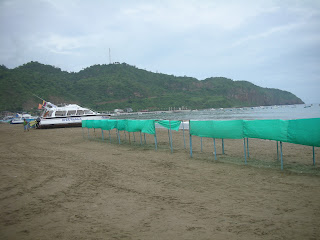Tuesday, March 12
evening to Wednesday, March 13
Since we missed the
Nicaragua port, the ship travelled very slowly up the coast of Central America
and Mexico and arrived at Cabo San Lucas late afternoon today. We will stay here overnight and then leave on
schedule Wednesday evening.
As we approach the
harbor, it was fun to be out on deck and watch for whales. We saw several of them just breaking the
surface of the water and blowing water up through the blowhole. The boat is anchored just off the famous El
Arco rock formation.
We had no real plans
for this port. A popular activity is to
go out on a whale watching boat. We did
that last time we were in Cabo so thought we would just spend some time walking
around the harbor area. The tenders were
running as soon as we anchored and people were anxious to get off the ship and
go to restaurants/bars and that endless browsing in the shops. We decided to stay on board and just enjoy
the quiet while looking at the lights of Cabo in the distance.
Then, just as we
were getting ready for bed, the phone rings and it’s our Aussie friends that
went to Iguazu with us. They had gone
ashore and booked a tour for Wednesday and wanted to know if we could join them
to round out the group of 8. So without
knowing what we were going to do, we said yes and quickly got the backpack
ready for an early departure in the morning.
We all met to get on
one of the first tenders after 7:00 am and off we went. The tour was a little road trip up the west
coast of the Baja and then back to Cabo and then up the east coast of the Baja peninsula.
 |
| Landscape filled with cacti--looked like AZ to us |
We drove about 25
miles to a little town of Todos Santos, first stopping at Ranchera, a lovely
resort on the oceanfront. The grounds
and facilities were beautiful and it would be a very restful vacation to spend
some time there.
 |
| Ranchera Resort |
Then it was back on
the road to Todos Santos, where the highlight seemed to be the Hotel
California. Now I thought the Hotel
California was in Hollywood, but here’s another one. Appropriately named as the east coast of the
Baja borders California Bay. If the song
“Hotel California” was not running through your mind before arriving, you
certainly mastered it while strolling through the gift shop, which was
basically all we saw.
 |
| Gramae and Marion enjoying coconut milk |
 |
| The town's mission |
After a little walk
through the town, which is very nice, we headed back to Cabo San Lucas so we
could drive up the east coast. The town
we arrived at was Los Cabos and again was very nice, clean, and well set up for
the tourist industry with lots of restaurants and hotels.
 |
| Beautiful pottery but very expensive |
On the way back to the
port, our driver almost hit a donkey that suddenly jumped down onto the
highway. I’m sure I could see the donkey’s eyeballs as we narrowly missed it—and
we were sitting in the back of the van!
We made a stop at the local Wal-Mart as our Aussie friends needed to buy
a suitcase to haul home all the treasures they have collected over the past 3
months they have been travelling. They
started just after Christmas by flying to LAX, then taking a train to San Diego
to board a cruise ship that took them through the Panama Canal and then to Fort
Lauderdale. Then they boarded the Grand
Princess and sailed the Caribbean for a week before we all met up on this
cruise. They came a long way for this
vacation and they certainly made the most of it, including side trips from this
ship to both Iguazu Falls in Argentina and Macchu Pichu in Peru. They needed an extra suitcase for all their
souveniers.
 |
| Cute little girl playing the marimba with her father |
Back on the ship, we
were up on deck as the ship pulled away from the harbor. We spotted several whales and one in
particular gave us a good farewell wave as he flipped his tail up about 5 times
in succession.
Well, that’s the
last port before arriving to our final destination, San Francisco on Saturday. It has been the most wonderful vacation. We met lots of great people and hope to
cruise again with some of them in the future.
South America was never even in our radar before booking this cruise 2
years ago. We’re glad we did, though,
and feel that even though our time at the ports was brief, we left with the
satisfaction of getting a pretty good overall exposure to cultures and sites a
bit different from our own.
It is an adventure
we would enthusiastically recommend!
Goodbye for
now. Our next adventure is planned for
August when we visit London, cruise the British Isles and then do a transatlantic
cruise across the ocean stopping in Iceland and Greenland along the way.




























































